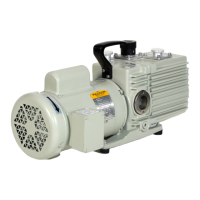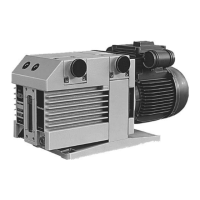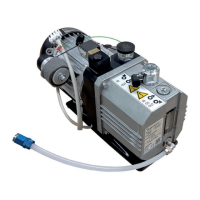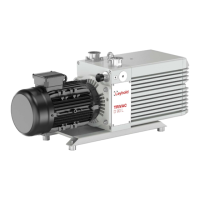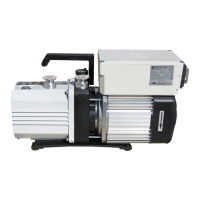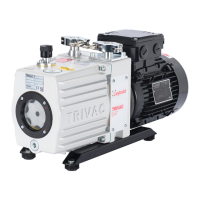b (Cont'd.) (1) Take
the
Step
F-5 assembly and insert its HV-stage end (the end
that
has
two
pulling
holes
on
the
outside end
of
the rotor) down into
the
HV
stage cylinder (55) until the
center bearing plate (52) rests against the
HV
stage cylinder (55) (see Figure 5-19).
(2) Align
the
two alignment holes
in
the
center
bearing plate (52) with
the
two
upper
align-
ment holes on the
HV
stage
cylinder (55).
(See
Figure 5-19).
(3) NOTE: When driving the
two
long cylindrical pins (65) into
the
alignment holes, the
flat end (nonbeveled end)
of
the
pins (65) should face
the
HV
cylinder (55). The
HV
cylinder
is
the
one with
the
intake tube portion.
REQUIRED ACTION: Using a rubber hammer, hit
the
beveled end
of
the
pins
to
drive
the
two
long cylindrical pins (65) down through the
two
alignment holes
in
the
center
bearing plate
(52), then through the
two
upper alignment holes
in
the
HV
cylinder (55)
until
the
flat end
of
each pin extends just
out
of
each upper HV-cylinder alignment hole
(see Figure 5-19).
(4) Ensure
that
the
center bearing plate (52) and
the
HV
stage cylinder (55) are tight
against each
other
and
that
they remain tight
throughout
the
module assembly sequence.
c.
Place
the
second stage
pump
cylinder (46) so
that
it
is
lying flat with
the
top
edge (the flat portion
that
has the screw holes, exhaust holes, and
gas
ballast hole) on the right facing away from you.
Fit an D-ring (47) into
the
D-ring groove on the cylinder (46) surface
that
is
facing up.
For D30A, D60A, and D90A
pump
models, the second stage cylinder (46) should be lying flat on
an open vice
or
other
open support, so
that
the shaft can be inserted through
it
in
Step d(3).
d. Attach
the
assembly
that
you
put
together
in
Step b(3)
to
the second stage
pump
cylinder
as
follows (see Figure 5-20):
(1) Take the assembly from Step b(3) and insert its second-stage end (the end
that
has the
longer section
of
the shaft) down into
the
second stage
pump
cylinder (46).
(2) NOTE: When aligned correctly, the flat portions
of
the
top
of
the
two
pump
cylinders
\(46/55)
are
in
line with each other.
REQUIRED ACTION: Align the beveled end
ofthe
two
long cylindrical pins (65) (the
pins which extend
out
of
the alignment holes
in
the center bearing plate (52)) with
the
two
upper
alignment holes
in
the second stage cylinder (46).
(3) NOTE: When Step d(3)
is
completed,
the
beveled ends
of
the
two
long cylindrical pins
(65) should extend most of the way through the upper alignment holes
in
the second
stage
pump
cylinder (46).
REQUIRED ACTION: For the D2A, D4A, D8A, and D16A pump models, while keep-
ing
the
assembly vertical, pull the second stage cylinder (46) straight
up
over
the
long
cylindrical pins (65) until it
is
tight against the center bearing plate (52) (see Figure
5-20).
For
the
D30A, D60A, and D90A pump models only, while keeping the assembly
vertical, push the Step b(3) assembly straight down until
it
is
tight against the second
stage cylinder (46).
(4) Ensure
that
the
cylinders (46/55) and center bearing plate (52) remain tight against
each
other
throughout
the
module assembly sequence.
e.
NOTE:
If
you
are reusing the old vanes (53), make sure
that
each used vane
is
replaced
in
its same
rotor slot. Also make sure
that
the orientation
of
each vane
is
the
same
as
it was before disassem-
bly so
that
each used vane
is
not
turned end-far-end
in
its slot.
NOTE: Be sure
that
the
slotted
edge
of
the
vanes (53) faces the
center
of
the rotor (54) when inserting
the
vanes
into
the rotor. .
NOTE: For the D4A, D16A, D60A, and D90A pump models only, the high vacuum stage rotor
(54) and vanes (53) are longer than the second stage rotor (48) and vanes (49). For these pump
models, be sure
to
insert the longer vanes (53) into
the
high vacuum stage rotor (54).
TRIVAC "A" Manual, Edition L
37
